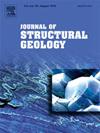动态再结晶橄榄石在复杂变形条件下的微观结构和CPO演化:一种全场数值模拟方法
IF 2.9
2区 地球科学
Q2 GEOSCIENCES, MULTIDISCIPLINARY
引用次数: 0
摘要
地幔岩石的流变性能在很大程度上取决于它们的晶体优先取向。橄榄石CPO,由平行于流动方向的地震快轴方向定义[100],也被认为是地球上地幔地震各向异性的主要贡献者。然而,在已有织物上叠印新CPO所需的变形量以及继承的CPO对瞬态微观结构演变的影响仍然未知。本研究采用全场数值方法(VPFFT-ELLE)研究复杂变形条件下橄榄石多晶聚集体的动态再结晶和微观组织演化。我们测试了连续纯剪切和简单剪切边界条件的四种组合。研究结果表明,遗传的CPOs以依赖于连续阶段之间的运动学关系的方式影响随后的变形。在所有情况下,微小的应变增量(ε ~ 0.3-0.6)足以消除先前的微观结构和CPO。而当变形条件发生显著变化(如拉伸方向发生正交变化)时,新形成的CPO强度明显降低,应变分布发生特殊变化。在瞬态应变阶段,原有的微观组织经历了广泛的重构,特别是当变形条件发生巨大变化时,例如从简单剪切状态切换到纯剪切状态,相对于拉伸方向平行缩短方向。我们估计了这些结果对解释地震速度各向异性观测的意义,认为纵波地震各向异性与橄榄石CPO随变形历史的演化显著正相关。这项研究强调了橄榄石聚集体中微观结构重排的短暂性,以及在具有复杂变形历史的地区解释地震各向异性的必要性,因为继承的CPOs会影响当前的结构发育并导致对当前变形条件的偏离。本文章由计算机程序翻译,如有差异,请以英文原文为准。
Microstructure and CPO evolution of dynamically recrystallized olivine during complex deformation conditions: a full-field numerical modeling approach
The rheological properties of mantle rocks are strongly dependent on their crystallographic preferred orientation (CPO). Olivine CPO, defined by the orientation of seismically fast [100] axes parallel to flow direction, is also thought to be a dominant contributor to seismic anisotropy in the Earth's upper mantle. However, the amount of deformation needed to overprint a new CPO on a pre-existing fabric and the impact of the inherited CPOs on the transient microstructure evolution, remain unknown. This study employs a full-field numerical approach (VPFFT-ELLE) to explore the dynamic recrystallization and microstructural evolution of olivine polycrystalline aggregates under complex deformation conditions. We test four combinations of successive pure shear and simple shear boundary conditions. Findings indicate that inherited CPOs influence subsequent deformation in a manner dependent on the kinematic relationship between successive stages. In all cases, a minor strain increment (ε ∼0.3–0.6) is sufficient to erase the previous microstructure and CPO. However, when deformation conditions change dramatically (e.g., stretching direction changes orthogonally), the intensity of the new CPO developed is significantly lower and strain distribution are specially altered. During a transient strain stage, pre-existing microstructures undergo extensive reworking, especially when deformation conditions are changed dramatically, such as switching from simple shear to a pure shear condition with a parallel shortening direction relative to the stretching direction. We estimate the significance of these results in interpreting observations of seismic velocity anisotropy, concluding that P-wave seismic anisotropy is significantly and positively correlated with the evolution of olivine CPO with deformation history. This research underscores the transient nature of microstructural rearrangement in olivine aggregates and the necessity for caution in interpreting seismic anisotropy in regions with complex deformation histories, as inherited CPOs can influence current fabric development and induce deviation to the present deformation conditions.
求助全文
通过发布文献求助,成功后即可免费获取论文全文。
去求助
来源期刊

Journal of Structural Geology
地学-地球科学综合
CiteScore
6.00
自引率
19.40%
发文量
192
审稿时长
15.7 weeks
期刊介绍:
The Journal of Structural Geology publishes process-oriented investigations about structural geology using appropriate combinations of analog and digital field data, seismic reflection data, satellite-derived data, geometric analysis, kinematic analysis, laboratory experiments, computer visualizations, and analogue or numerical modelling on all scales. Contributions are encouraged to draw perspectives from rheology, rock mechanics, geophysics,metamorphism, sedimentology, petroleum geology, economic geology, geodynamics, planetary geology, tectonics and neotectonics to provide a more powerful understanding of deformation processes and systems. Given the visual nature of the discipline, supplementary materials that portray the data and analysis in 3-D or quasi 3-D manners, including the use of videos, and/or graphical abstracts can significantly strengthen the impact of contributions.
 求助内容:
求助内容: 应助结果提醒方式:
应助结果提醒方式:


